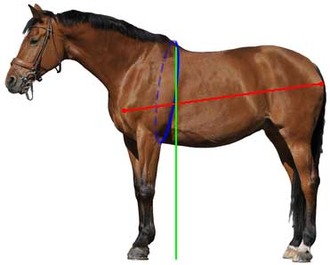
Common equine body measurements
The heart girth, height at the withers, and length from the point of the shoulder to the point of the buttock are the most common measurements used to determine an equine's weight.
Online equine calculators require measurements of your horse, donkey or foal in order to estimate weight. The accuracy of these calculators is dependent on the accuracy of the measurements. Please note that EquiMed weight calculators are based on scientific research, but that individual animal differences may cause over or under estimation of your animals weight. If you need accurate weight measurements, use a calibrated scale designed for weighing livestock.
What measurements are required?
Most weight calculators require one or more measurements. The most common measurements are:
- Heart girth
- Body length (point of shoulder or elbow to point of buttock)
- Height measured at the withers
How do I measure heart girth?
The most common measurement required by most calculators is heart girth. This is a measurement around the thoracic region of the animal. The best way to measure this is to take a piece of string or twine, circle it around the body, placing it just behind the animal's elbows and over the location where the withers meets the backbone.
Cut or mark the twine, and then measure the length that encircled the body. This is the heart girth.
See the blue line on the equine illustration above for the proper placement.
Caution: We do not recommend using a metallic tape measure to measure the heart girth. The sound and feel of the metallic tape frightens many horses and may cause a dangerous situation.
How do I measure the length?
Different calculators may call for different points of measurement to determine the length. Read the calculator instructions carefully to make sure you are measuring the correct length.
Most calculators require the measurement from the point of shoulder to the point of buttocks (or pin bone). Examine the image above (red line) to understand these points. We recommend that you use your hands to press firmly in the area of the point of shoulder to find the point. Do the same for the pin bone. Note that both of these points are slightly wrapped to the front and rear of the horse.
After finding the points, use a piece of string or twine stretched from one point to the other. Mark the string or twine and then measure it to get the length.
How do I measure height?
Equine height it measured from the bottom of the hoof level to the top of the withers. Height measurements are usually indicated in hands, with a hand being equivalent to 4 inches. For example, a 16 hand horse will measure 64 inches (4 x 16) at the withers.
Measuring sticks and other devices are available for measuring height. Only the most accurate weight calculators require a height measurement (green line).
If you do not want to invest in an equine measuring stick, we recommend that you take a simple tape measure, extend it from the floor level to above the height of the withers of your horse, and then nail it to a vertical wood surface in your barn. You can then walk your horse in front of the tape measure and sight across the withers in a level manner to read the measurement on the tape measure.
It is important that you view the measure directly level across the horse's withers for the most accurate measurement.
Dig deeperTM
Now that you know how to measure your equine, put the knowledge to use! Use our horse weight calculator. The calculator works for horses, donkeys and even for foals!
You may also want to learn more about feeding your horse, another area where the horse weight is important to know. See our horse feed calculator for more information.
